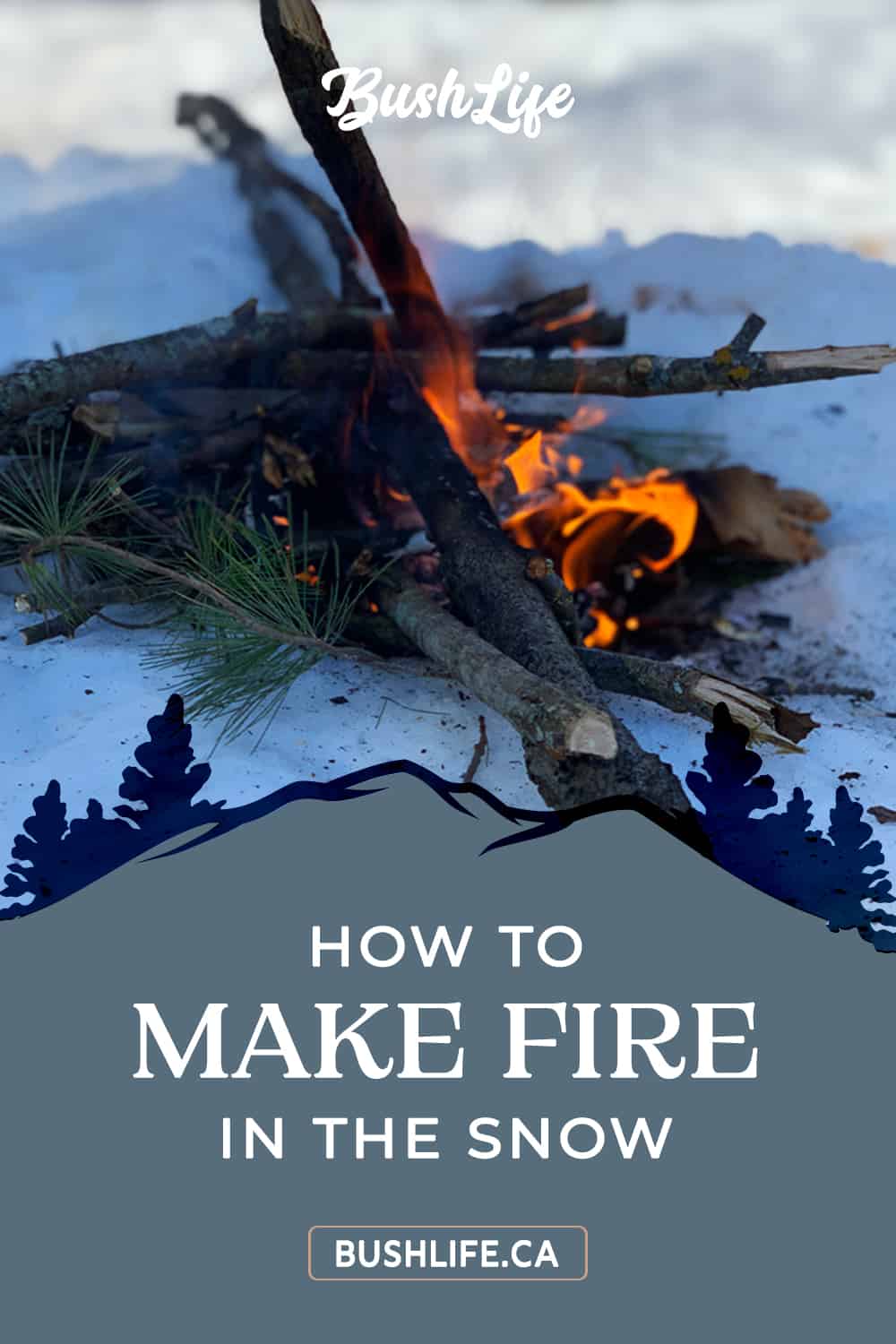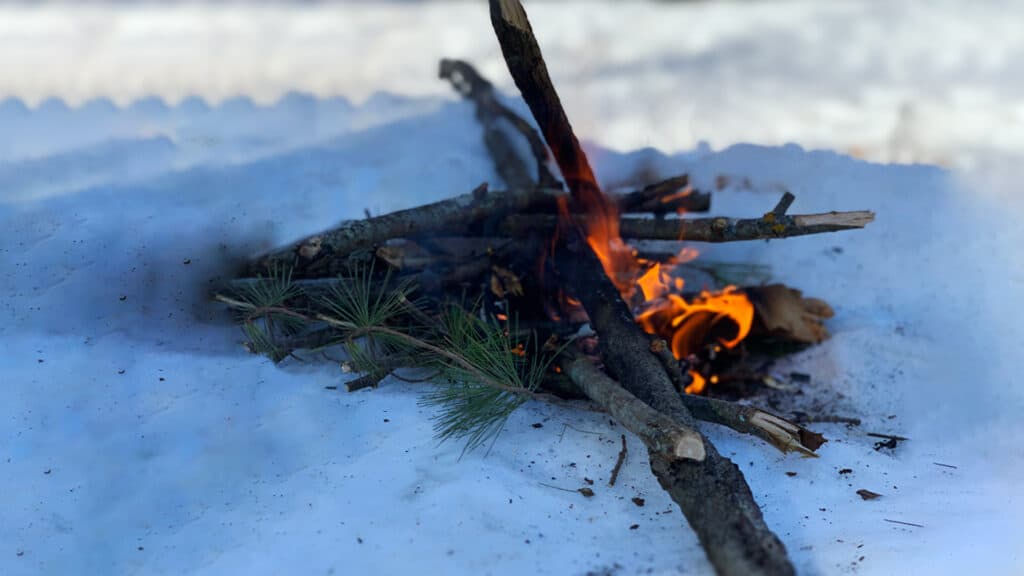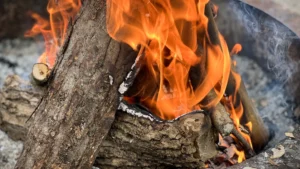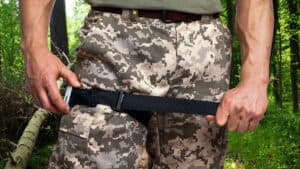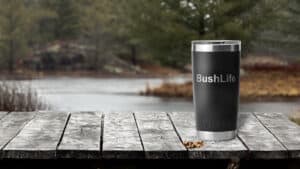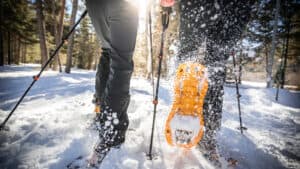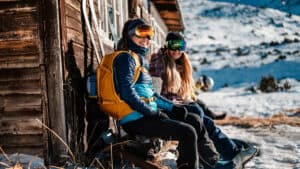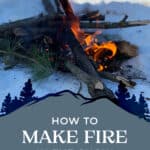We just had our first snow! It lasted a week and melted. But before long, there’ll be a multiplier of feet of snow on the ground that won’t go away anytime soon. So it begs the question, can you make fire in the snow?
This is BushLife, so of course you can, and I’ll show you how. There’s no reason why we can’t enjoy a fire on our backcountry adventures. And worse, we may NEED a fire for a survival situation one day. So, it’s another skill to add to your skillset to be confident in the woods!
Discloure: Posts may contain affiliate links. Purchases made through our links result in a small commission to us at no charge to you. We only recommend products that meet our brand standards based on testing and first hand use by our authors.
Where Do You Find Dry Wood?
The first part of any fire is always fuel. No Wood = No Fire. But if you have ever tried to burn wet wood, you’ll know it’s a complete and utter nightmare. The trick is on a summer’s rainy day – find dead-standing wood. The last place to source your wood is off the ground. Any log lying on a forest floor is soaking up moisture from the ground. In today’s context, it’s also buried in snow and getting wet from multiple sides.
What is a Dead-Standing Tree?
A dead-standing tree is when a tree dies and is still standing. The tree dries out a lot better.
In addition to the above, when you look at a dead-standing tree, you should know that some sections are better than others. For example, a large protruding branch creates a shoulder pocket on its underside where it meets the main trunk. This shoulder pocket will be its driest section.
You have a knife on you, correct? We’ll get to that in just a minute. If the outside layer of that dead-standing tree branch is wet, that’s fine because the inside of it is likely dry. With some essential tools, you can expose the dry inner and have your fuel to start a fire.
Basic Cutting Tools
A knife is your best friend in the woods. If you could only have one tool, this is it. I carry the Morakniv Garberg Carbon, and it has a full tang. That means it’s strong enough that I can use a piece of wood to bash the knife and baton through big pieces of wood – essentially, creating an axe.
With our review of the Morakniv Garberg Carbon knife, you’ll learn some vital skills that can coincide with using an exceptional knife. Particularly feather sticking – as it helps immensely with any fire-making situation, let alone fire in the snow.
The second thing you want is a saw. A saw can process more wood and do it faster than an axe. I carry the Silky Big Boy and absolutely love this saw. I won’t go into the woods without it, and I have removed many downed trees that have fallen across the trail – blocking my access to get out, whether it’s on an ATV, sled or even the car on a backwoods road. It’s a light folding saw that fits in a backpack but is big enough to garberate some big trees!
Of course, there’s always the good old axe. If you love your axe and must have it, take it with you. Just remember not to bring your regular axe or maul. You want a pack axe that’s more manageable to haul if you are on foot or tight for space.
Further Reading: Silky BIGBOY: Why A Saw Beats an Axe Every Time
Prioritize Your Tools
At a minimum, ALWAYS carry a suitable knife when in the woods. If carrying an appropriate pack, have a knife and a saw at a minimum. It doesn’t matter if you are on a hike, ATV, sled, etc. Always carry essential gear for those SHTF scenarios, especially during the colder months.
Prep Your “Fire in the Snow” Fire Place
Prep is the big one for fire in the snow! What do we do when we make fire?
- Tinder on the bottom
- Kindling on top of your tinder pile
- Main pieces on top of kindling
That’s not going to work to make a fire in the snow. For the record, backward fire lays are where the kindling is on top of the wood, and the fire burns down. But let’s not go there today. We will steal one idea from the reverse fire lay in a minute.
If you find a “fire pit,” Ie. Dirt with rocks around it that you or someone else built will be full of snow. Even if you can clear out a good chunk of the snow and get a fire going, the snow will melt as the heat rises. That will put out your hot coals on the bottom, essentially the heart of the fire. Even if you manage to get past that, the melting water will bubble and steam in the ashes, which becomes a constant uphill battle.
Your Fire in the Snow Solution
The easiest solution is to clear the snow from an area – any safe, flat spot will do. It doesn’t have to be perfect, so long you remove the heavy stuff. Place a layer of rocks down as a base. No rocks available? I figured as much, but that’s fine as well. Use wood! Cut thick branches or log pieces with your saw and lay them on the ground. You’ll use this as your base to get your fire out of the snow. You can then build a regular firelay on top the way you are used to, and your fire will burn.
The Plow Pile!
I’ve used the wood underlay method above on the side of my driveway. You know what I mean, the snowbank that’s about 3-4 feet high from plowing the driveway. The top photograph was its start. I still don’t know how, as it’s remarkable, but I managed to get it to burn all the way down to the ground! It took forever, but the fire burned without going out. I suspect as the melt dribbled, it refroze in the snow below, creating a hard ice layer that the fire “sat” on. My point is that if you can make a fire in the snow, on top of 3′, you can easily do it on the ground over inches of snow.
3 Sources of Ignition
Here’s a recurring theme on this blog and for anyone else who knows what they are talking about. ALWAYS carry three sources of ignition! If you are reading about making fire in the snow, there’s a good chance you want the knowledge to conquer a survival situation. The following three items hardly take any room or weight, so make sure you carry the backup to the backup and don’t learn this the hard way.
Further Reading: 7 Fire Kit Survival Essentials That You Should Carry
Bic Lighter
The Bic is the gold standard for fire-making, and it’s as cheap as dirt. It’s always wise and fun to learn different methods of fire making. But don’t kid yourself when you need to start a fire – the rule of thumb still applies. Use the fastest and easiest method you have.
The Bic gets a bad wrap for two reasons. One is that it doesn’t work when it’s cold. While this is true, I don’t have that problem, as I keep mine in an inner pocket close to my body. It’s an issue for any gas lighters, so it’s not just a Bic problem rather than a fuel problem.
The second is water. Yes, if you drop it in water and it gets water-logged, it won’t work. But if you blow on it fiercely, it’s far easier than you think to dry it out and get it working again. I’m talking 30 seconds here, and you can fix a wet Bic.
Matches
This one’s a no-brainer, sort of. Matches have changed over the years. Don’t take the cute and cuddly candle matches into the woods. We have super matches nowadays that come in waterproof containers, such as the UCO Stormproof Match Kit.
Ferrocerium Rod

The fire steel! Throwing sparks in the thousands of degrees, thousands of times and working in any weather conditions. It’s the ultimate backup. Not sure how to use a Ferro Rod – no worries, we’ve got you covered in How to Use a Ferro Rod. It’s a skill set that you should know and master.
In a nutshell, carry some vaseline-soaked cotton balls in a ziplock, which is foolproof. The spine of the Morakniv Garberg Carbon knife I keep talking about will work with the Ferro Rod to generate those very sparks. That’s, of course, if you lose the striker that comes with the Ferro Rod. Kick it up yet another notch with a rod and magnesium bar combo, such as the Fire-Fast Trekker.
Let’s Get Back to Fuel for a Fire in the Snow
This post assumes you have some basic fire knowledge, which we can skip. We covered what tools you need and why. We also covered elevating the fire off the ground and snow, which is the single most important takeaway today. Let’s hone in on those wood skills a little more before we wrap up.
How to Identify a Dead-Standing Tree
It’s late fall, winter or early spring since there’s snow on the ground. That also means the leaves are down, and let’s face it, most deciduous trees look the same now. It can be challenging to spot a dead tree this time of year.
If a tree is split heavily somewhere from storm damage or leaning super heavily, it’s probably dead. Ash trees are dying in droves thanks to the Emerald Ash Borer Beetle. With dead ash trees, you’ll notice the tree is missing a lot of bark. Underneath, the barkless sections will be a brighter yellowish colour. Trees missing a lot of bark are always a dead giveaway.
Woodpecker or rot holes are typically a good sign of dead or dying trees. And, of course, when a tree looks sickly or rotting, it’s a good sign you found a winner.
Other Useful Trees
The bark from birch trees makes for excellent tinder. Birch bark will burn for a fair amount of time and is a great free resource. Scrapping birch bark (with the knife’s 90-degree spine, like the Morakniv Garberg) and then using the Ferro Rod on it works well – if you forgot the cotton balls at home!
Fatwood from Pine is fantastic, but learning how to find it takes time. It’s the exception to dead trees on the ground. When a pine tree dies, all the oily sap inside it, which burns exceptionally, will flow to the bottom – this includes branches sticking up on a flat laying tree! That means you can find it accessible from the forest floor. Like birch bark, you can scrape fatwood using a Ferro Rod. These shavings can then be used as tinder. Even larger pieces will burn extremely well.
Punk wood. Wood that is rotting turns “punky.” You’ll know a rotting piece by sight, but it’s also substantially lighter. Punk wood is another excellent fire starter, and it’s another item scooped from the forest floor. Just don’t forget, you can open wood up and grab inner pieces which are drier.
RELATED: How to Build a Campfire: The Basics of Fire Building
Fire in the Snow
Don’t just read about fire-making in the snow – get out and try it! You’ll be happy you did, especially if you ever find yourself in a situation where you need to make a fire in the snow for survival. Next time you are in the woods, make it a habit to learn how to identify dead-standing trees.
Lastly, take the kids on a fatwood scavenger hunt. Why pay $20 for a small piece in an outdoor store? When you find a good section in a tree, you’ll find what would have cost you hundreds of dollars if you had to buy it in-store. If successful, throw some in your pack and understand that all the time you just spent looking for it will save you when you need it most one day.
If you found this post helpful, please consider sharing. Thank you!
Bookmark this post on Pinterest for future reference!
